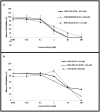Drug Repurposing of the Anthelmintic Niclosamide to Treat Multidrug-Resistant Leukemia
- PMID: 28344555
- PMCID: PMC5344920
- DOI: 10.3389/fphar.2017.00110
Drug Repurposing of the Anthelmintic Niclosamide to Treat Multidrug-Resistant Leukemia
Abstract
Multidrug resistance, a major problem that leads to failure of anticancer chemotherapy, requires the development of new drugs. Repurposing of established drugs is a promising approach for overcoming this problem. An example of such drugs is niclosamide, a known anthelmintic that is now known to be cytotoxic and cytostatic against cancer cells. In this study, niclosamide showed varying activity against different cancer cell lines. It revealed better activity against hematological cancer cell lines CCRF-CEM, CEM/ADR5000, and RPMI-8226 compared to the solid tumor cell lines MDA-MB-231, A549, and HT-29. The multidrug resistant CEM/ADR5000 cells were similar sensitive as their sensitive counterpart CCRF-CEM (resistance ration: 1.24). Furthermore, niclosamide caused elevations in reactive oxygen species and glutathione (GSH) levels in leukemia cells. GSH synthetase (GS) was predicted as a target of niclosamide. Molecular docking showed that niclosamide probably binds to the ATP-binding site of GS with a binding energy of -9.40 kcal/mol. Using microscale thermophoresis, the binding affinity between niclosamide and recombinant human GS was measured (binding constant: 5.64 μM). COMPARE analyses of the NCI microarray database for 60 cell lines showed that several genes, including those involved in lipid metabolism, correlated with cellular responsiveness to niclosamide. Hierarchical cluster analysis showed five major branches with significant differences between sensitive and resistant cell lines (p = 8.66 × 105). Niclosamide significantly decreased nuclear factor of activated T-cells (NFAT) activity as predicted by promoter binding motif analysis. In conclusion, niclosamide was more active against hematological malignancies compared to solid tumors. The drug was particularly active against the multidrug-resistant CEM/ADR5000 leukemia cells. Inhibition of GSH synthesis and NFAT signaling were identified as relevant mechanisms for the anticancer activity of niclosamide. Gene expression profiling predicted the sensitivity or resistance of cancer cells to niclosamide.
Keywords: chemotherapy; drug resistance; oxidative stress; pharmacogenomics; transcription factors.
Figures







Similar articles
-
Repurposing of Bromocriptine for Cancer Therapy.Front Pharmacol. 2018 Oct 8;9:1030. doi: 10.3389/fphar.2018.01030. eCollection 2018. Front Pharmacol. 2018. PMID: 30349477 Free PMC article.
-
Modulation of P-glycoprotein activity by novel synthetic curcumin derivatives in sensitive and multidrug-resistant T-cell acute lymphoblastic leukemia cell lines.Toxicol Appl Pharmacol. 2016 Aug 15;305:216-233. doi: 10.1016/j.taap.2016.06.002. Epub 2016 Jun 16. Toxicol Appl Pharmacol. 2016. PMID: 27318188
-
Cytotoxicity of South-African medicinal plants towards sensitive and multidrug-resistant cancer cells.J Ethnopharmacol. 2016 Jun 20;186:209-223. doi: 10.1016/j.jep.2016.04.005. Epub 2016 Apr 4. J Ethnopharmacol. 2016. PMID: 27058630
-
Pharmacological advances and therapeutic applications of niclosamide in cancer and other diseases.Eur J Med Chem. 2025 Jun 5;290:117527. doi: 10.1016/j.ejmech.2025.117527. Epub 2025 Mar 20. Eur J Med Chem. 2025. PMID: 40153934 Review.
-
Drug Repurposing: Research Progress of Niclosamide and Its Derivatives on Antibacterial Activity.Infect Drug Resist. 2024 Oct 21;17:4539-4556. doi: 10.2147/IDR.S490998. eCollection 2024. Infect Drug Resist. 2024. PMID: 39464831 Free PMC article. Review.
Cited by
-
Bioenergetic modulation with the mitochondria uncouplers SR4 and niclosamide prevents proliferation and growth of treatment-naïve and vemurafenib-resistant melanomas.Oncotarget. 2018 Dec 11;9(97):36945-36965. doi: 10.18632/oncotarget.26421. eCollection 2018 Dec 11. Oncotarget. 2018. PMID: 30651927 Free PMC article.
-
Targeting S100A4 with niclosamide attenuates inflammatory and profibrotic pathways in models of amyotrophic lateral sclerosis.J Neuroinflammation. 2021 Jun 12;18(1):132. doi: 10.1186/s12974-021-02184-1. J Neuroinflammation. 2021. PMID: 34118929 Free PMC article.
-
Niclosamide-A promising treatment for COVID-19.Br J Pharmacol. 2022 Jul;179(13):3250-3267. doi: 10.1111/bph.15843. Epub 2022 Apr 11. Br J Pharmacol. 2022. PMID: 35348204 Free PMC article. Review.
-
A Niclosamide-releasing hot-melt extruded catheter prevents Staphylococcus aureus experimental biomaterial-associated infection.Sci Rep. 2022 Jul 19;12(1):12329. doi: 10.1038/s41598-022-16107-4. Sci Rep. 2022. PMID: 35854044 Free PMC article.
-
In Vitro Evaluation and Mitigation of Niclosamide's Liabilities as a COVID-19 Treatment.bioRxiv [Preprint]. 2022 Jul 13:2022.06.24.497526. doi: 10.1101/2022.06.24.497526. bioRxiv. 2022. Update in: Vaccines (Basel). 2022 Aug 09;10(8):1284. doi: 10.3390/vaccines10081284. PMID: 35860224 Free PMC article. Updated. Preprint.
References
-
- Allen J. D., Brinkhuis R. F., van Deemter L., Wijnholds J., Schinkel A. H. (2000). Extensive contribution of the multidrug transporters P-glycoprotein and Mrp1 to basal drug resistance. Cancer Res. 60 5761–5766. - PubMed
-
- Bartsevich V. V., Juliano R. L. (2000). Regulation of the MDR1 gene by transcriptional repressors selected using peptide combinatorial libraries. Mol. Pharmacol. 58 1–10. - PubMed
LinkOut - more resources
Full Text Sources
Other Literature Sources
Miscellaneous

